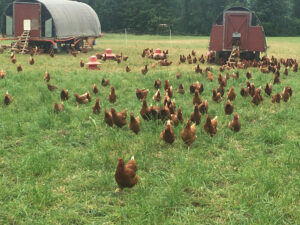Multispecies Grazing: A Primer on Diversity
By Lee Rinehart, NCAT Agriculture Specialist
Abstract
This publication discusses the principles and practices of grazing multiple species of livestock on pastures. Here, you’ll find a discourse on the benefits of multispecies grazing on productivity and profitability, including its positive impacts on pasture diversity and health. Also covered are grazing dynamics (how diverse animal species use grazing resources), the types and kinds of fencing and working facilities needed by various animals, and how to deal with predators, mineral supplementation, and parasites. Finally, it covers vegetation management and how to make stocking-rate decisions.
Contents
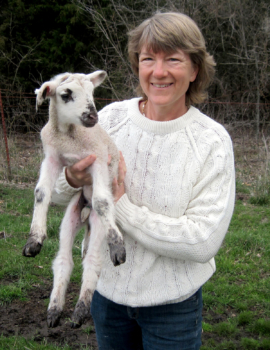
Introduction
Benefits of Grazing Multiple Species
Pasture Diversity and Health
Grazing Dynamics
Fencing and Working Facilities
Predators
Mineral Supplementation
Managing Internal Parasites
Animal Health Considerations
Stocking-Rate Decisions
Grazing Pigs
Grazing Planning and Monitoring
Summary
References
Further Resources
Introduction
The sacred is unique, wholesome, interconnected…” —Suzanne Karreman
Suzanne Karreman spoke about diversity as she flipped though pictures of her farm. She was giving a talk with her husband Hue at the 2018 Grassworks Conference in Wisconsin Dells, Wisconsin. As multispecies graziers, they extend the concept of diversity to all walks of their life together, and with their community, on the farm. Diversity, for Suzanne, is the antithesis of the separateness and scarcity that define our market-driven world, with its focus on economies of scale and cheap products. Instead, she speaks of a sacred economy…one that binds people together and integrates local ecologies with all aspects of human life. All life is unique, wholesome, and integrated. Thus, extending this concept to the pastures she manages is a natural farm application of her life philosophy.
Resilient farms are based on diversity of life, and while much of the focus of agricultural sustainability of late has been on diversity of crops, forages, and soil microbial populations, not much has been said about the diversity of grazing species. “The presence of multiple species of large herbivores is the typical condition of grassland and savanna ecosystems,” says John Walker, a range ecologist who wrote on the subject over two decades ago (Walker, 1994). I was taught in college to plant one or two species of pasture forages and graze them continuously with a single livestock species. If you drive around the countryside this is generally what you still see: a closely grazed pasture with leggy tufts of mature stalks from less-palatable plants, and cattle or sheep scattered over the area, easily selecting the newest growth and thereby bringing selection pressure to bear in causing the eventual demise of the best forages. But this paradigm, though prevalent, is changing.
There has long been an interest in grazing multiple species together, either sequentially or at the same time. In my travels, I’ve seen more producers adding to the diversity of their farms, not only by adding diverse pasture mixes and cover crops, but with multiple species of livestock. There are some very good reasons for doing this, and this publication will discuss those reasons and some practical tips and ideas producers can think about when creating more diversity on their farms.
Benefits of Grazing Multiple Species
Multispecies grazing takes full advantage of biological diversity. Those farmers who work hard to increase pasture-plant diversity will also see an even greater advantage by adding diversity of livestock to the mix. In fact, they go hand in hand. Multispecies grazing works best, and excels, when a multitude of forage species make up the pasture composition. “Vegetation can maintain a stable composition under higher foraging pressure when two herbivores rather than one are used to stock a pasture” write Anderson et al. (2012). As vegetation of pastures becomes more diverse, multispecies grazing tends to improve composition and utilization.
Multispecies grazing increases carrying capacity. Anderson et al. (2012) note that this management practice “may be one of the most biologically and economically viable systems available to producers, especially on landscapes that support heterogeneous plant communities.”
Studies have shown that when you add sheep to a cattle herd, you get 20 to 25% greater productivity and carrying capacity over cattle alone, and 8 to 9% greater productivity and carrying capacity over sheep alone (Walker, 1994). This is because of the differences in grazing habits and the amount of dietary overlap between the species, which will be covered in more detail below.
Ecological resiliency and better pasture health. Because different animal species have different grazing habits and select various forages and combinations of forages, pastures that are grazed with multiple species have more uniform defoliation. Defecation patterns affect nutrient cycling and plant–animal nutrition, note Anderson et al. (2012), and “although cattle prefer not to graze around their dung, sheep have been reported to graze around cattle dung, thus increasing the utilization of pasture” (Anderson et al., 2012). This uniformity of grazing contributes greatly to forage quality and resiliency by keeping forage growth constant; resetting the plants to the same stage of growth with each grazing event and preventing weedy or unpalatable plants from taking over.

Goats can be used to control weeds and brush in diverse pastures. Photo: Lee Rinehart, NCAT
In addition, it has been noted that “grazing systems consisting of sheep and cattle grazing improved livestock productivity and reduced methane emissions relative to sheep only systems” (Fraser et al., 2014). Thus, not only are there motivations to utilize multispecies grazing due to its positive effects on animal productivity and soil health, but from its apparent positive impact on carbon emissions.
Vegetation management. Pastures that have infestations of weeds or brush can be grazed with species appropriate to the plants present, which reduces the ability of any one plant species to dominate the landscape. Grazing managers must understand the growth habits of weeds and desirable plant species and know what animals graze them, in order to target-graze such that weeds are reduced and palatable plants are allowed enough rest to recover. This is especially important where invasive plants are involved. One species may eat what another will reject and, by using the correct livestock, managers can suppress and reduce a weed problem in a cost-effective and ecologically responsible way. With knowledge of plant response to grazing and timing of grazing events, grazing managers can alter the landscape to a healthy, diverse, quality pasture. See Targeted Grazing: A Natural Approach to Vegetation Management and Landscape Enhancement–A handbook on grazing as a new ecological service for more information, including prescriptions for managing specific plants that may be dominating your pastures.
Parasite control. Combined with an integrated parasite-management plan, grazing multiple species together or in sequence can reduce parasite populations due to timing of grazing and the characteristics of the parasites that infect each species of livestock. Given that sheep parasites do not usually affect cattle, cattle can be used to break the life cycle of sheep and goat parasites (and vice versa, generally). See the ATTRA publication Managing Internal Parasites in Sheep and Goats for more information.
Diversity of enterprises/income. Grazing two or more species together has been shown to increase animal production (Walker, 1994). As mentioned above, the carrying capacity is increased when two or more livestock species are grazed on the same pasture, resulting in higher productivity and increased cash flow from the greater production of added enterprises.
Other benefits. USDA researchers have noticed that when small ruminants are bonded to cattle to form one herd/flock (which they refer to as a flerd), they tend to remain together, which provides safety from predators and results in less time required to routinely check on livestock (Anderson et al., 2012). Bonding species together imparts many more benefits as well. For instance, it has been noted that cattle fencing can work very well for sheep when the sheep are bonded to cattle. Grazing distribution is enhanced as well, as sheep and goats tend to “spread themselves more evenly over the landscape during foraging compared with non-bonded flocks,” (Anderson et al., 2012). The concept of bonding is covered in more detail below in the Predators section.
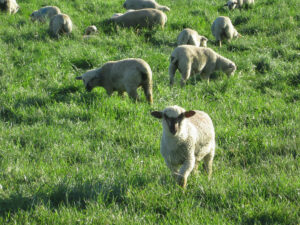
Well-managed livestock grazing contributes to healthy soil and productive pastures. Photo: Dave Scott, NCAT
Pasture Diversity and Health
Grazing, when controlled and matched to the pasture resource, is known to increase pasture health. Diversity is key here, and, just as diversity of plant species leads to greater soil health, having diverse animal species on the landscape adds a multiplier effect. Proper grazing increases soil aggregation, which enhances soil structure and allows for better water-holding capacity and nutrient exchange. Grazing also contributes soil organic matter and rumen microbes to the soil, which increases biodiversity, buffers soil temperature, escalates nutrient cycling, and minimizes soil compaction and disturbance. Producers who combine perennial pasture, cover crops in rotation on annual fields, and good grazing management with high species diversity will see benefits to soil health and increased revenue due to reduced inputs and higher productivity.
The Six Basic Principles of Managing for Healthy Soil
- Minimize tillage and soil disturbance: this preserves soil structure, encourages aggregation, and keeps soil carbon in the soil.
- Maintain living roots year-round: this feeds soil microorganisms.
- Provide soil cover: post-grazing residue of vegetation protects soil from loss of moisture and nutrients.
- Maintain species diversity: cover crop mixes and the use of diverse perennial-pasture mixes, incorporating warm-season and cool-season plants, both grasses and broadleaves, increases soil microbial biomass and nutrient cycling.
- Manage grazing through multi-paddock rotational grazing: appropriate grazing and rest periods prevent overgrazing and provide adequate plant recovery.
- Use animal impact: this provides nutrient cycling in pastures and contributes soil organic matter. Additionally, the grazing action on forage plants encourages root growth and root exudation of plant sugars that feed soil microorganisms.
The ATTRA publication Building Healthy Pasture Soils is a great resource for learning more about soil health, soil processes, grazing dynamics, and how to transition to sustainable soil management.
Also, see ATTRA’s Nutrient Cycling in Pastures, which details how producers can enhance the nutrient-cycling process through mimicking natural processes.
Grazing Dynamics
Competition has led animals on the same landscape to occupy different dietary niches and develop complementary forage preferences and grazing and dietary habits (Walker, 1994). These dissimilar grazing habits occur due to physical limitations on the animals’ ability to select forages (due to the morphological distinctiveness of their mouthparts) and physiological limitations or advantages on their ability to detoxify certain plants. Managers can exploit the selective grazing habits of different species to shape the landscape and diversify production. Again, a great resource is Targeted Grazing: A Natural Approach to Vegetation Management and Landscape Enhancement–A handbook on grazing as a new ecological service.
Livestock producers know that cattle, sheep, and goats eat different things, some of the time. If you were to observe a herd of diverse grazing animals, you’d notice that cattle diets generally consist of about 70% grass, 15% forbs (commonly called weeds but including any broadleaf herbaceous plant), and 15% browse (twigs and leaves of shrubs and brushy plants). Thus, rangeland scientists have termed cattle “grazers.” Sheep, termed “intermediate feeders,” eat a diet consisting of roughly 50% grass, 30% forbs, and 20% browse, while goats, adequately named “browsers,” consume around 30% grass, 10% forbs, and 60% browse. So, whereas there are some notable differences in diet choices among species, there is also some overlap. This overlap will be an important consideration when we come to stocking pastures, which will be covered later in this publication.
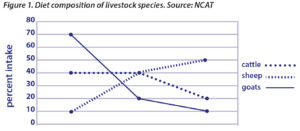
Earlier, it was mentioned that animals have physical limitations on their ability to select forages due to morphological differences. In other words, different species consume forages in different ways. Cattle are great at eating bunchgrasses, where they use a prehensile tongue to wrap a clump of forage off and rip it from the plant using an upward jerking motion with their head. Sheep, by contrast, are nibblers, and they use their teeth and upper dental pad to bite off forage leaves. This allows them to graze much lower in the sward than cattle and to concentrate on leaf consumption to maximize energy and protein intake in tall-grass grazing systems. On the other end of the spectrum are goats, nibblers as well, but they can handle tannin-rich plants and other types of toxins more easily than other animals, and they have the ability to reach high into a canopy by standing on their hind legs. Each species is very good at what they do, and the differences can be used by grazing managers especially well when applied to the appropriate landscape.
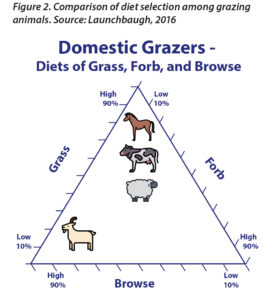
Producers should select animal combinations based on the plant species present. For example, let’s assume you have a grassy pasture that is composed of roughly 65% grass, 20% forbs, and 15% browse. What species would be best on this pasture?
Given that cattle are predominantly grazers, and sheep are intermediate grazers, these two species are likely to be the best match for this pasture. Notice in the diagram (above/below) how the diets of both cattle and sheep roughly overlap with the pasture resource. Now, let’s consider another scenario. Assume a pasture that is 30% grass, 20% forbs, and half browse.
Notice, in the corresponding diagram, the comparison between cattle and goat diets. In this scenario, the goat diet matches the pasture much better than the cattle diet. Cattle could be grazed with goats on this pasture and would put more pressure on the grass than would the goats, while the goats would munch on the browse. But care should be taken in this scenario to ensure that the cattle don’t overgraze the grass. This highlights the necessity of a good grazing and monitoring plan to ensure that the pasture is not overgrazed in any one species or plant type. More about grazing planning will be covered later in this publication.

What Goes with Cows, Sheep, and Goats?
Pigs and poultry do. Pigs on pasture seek high-quality vegetation, but get most of their nutrition from fed grains, due to their high energy and protein needs. The biggest impact they can have on a pasture is from their manure and their rooting activity. Poultry are, of course, seed eaters, but will pick green stuff and insects, and are particularly good at decimating fly larvae from manure paddies. Consider these species in rotation with large livestock. Hue Karreman (2018), a large-animal vet and livestock farmer in North Carolina, makes good use of these species by following cattle and sheep with poultry to pick through manure, then following them with pigs that renovate and aerate the pastures. After a good rest period, the pasture is ready for the next rotation.
Competition for resources is the engine that drives the dynamics of multiple species grazing on landscapes. Cattle or sheep alone, in a single herd, graze similar plants and can, if not managed properly, drive plant succession toward less-desirable forages. This is because competition for similar forages is greater among the same types of animals (intra-species) than it is among different types of animals (interspecies). Multispecies grazing reduces competition for specific forages and distributes defoliation of forages species more uniformly, so can result in a healthier, more diverse pasture.
Fencing and Working Facilities
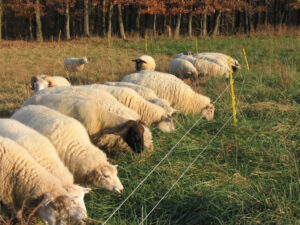
Two strands of electrified poly-wire can work well to contain grazing sheep in a paddock. Photo: NCAT
One of the first things you might be thinking if you are going to graze multiple species together is, “How do I deal with fencing?” This is probably the most critical and challenging component of multispecies grazing from a practical standpoint, and is a crucial question given the size and behavioral differences between livestock species. Your fencing should serve multiple purposes. Certainly you’re going to want to keep your animals off the highway or out of the neighbor’s garden. But you’ll also be using your fencing as a tool to control grazing in specific areas for specific animals.
Your perimeter fencing should be strong and permanent. Perhaps you already have a high-tensile fence in place. As long as it is high enough, with electric strands at the top and bottom, it will serve multiple species well. If you have a barbed wire fence you’ll likely want to strengthen it against small ruminants by running an electric wire at about knee height and putting fence stays between the posts on the fence line to keep animals from spreading the strands and getting out. Be sure to pay attention to gates and areas where terrain changes, or where fallen trees or stumps are near the fenceline. Goats have an uncanny ability to squeeze between gates and posts that otherwise work well for cattle or sheep.

Barbed wire should be avoided when stocking small ruminants. Photo: NCAT
Next, you’ll be thinking about how to deal with pasture and paddock subdivisions. This is the working part of your fence system that will place the animals just where you want them and will help you manage grazing for the benefit of the livestock and the pasture. There are so many options out there, and the first thing to think about is what you have on hand. Is it appropriate for multiple species? For instance, if you currently divide your paddocks with polywire or polytape, this can work for cattle, sheep, or goats, especially if you use three strands. These materials are portable and allow you to adjust paddock size as resources and herd size demand. For fairly small paddocks, electrified netting works great and is really easy to move.
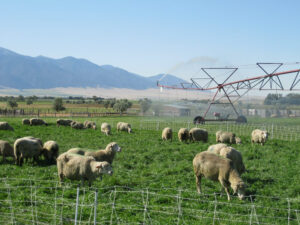
Multi-paddock rotational grazing uses sequential paddocks and frequent moves to utilize forage efficiently and provide adequate forage rest and recovery. Photo: Dave Scott, NCAT
However, for larger paddocks, some producers have suggested that woven wire with two electric wires, offset and at the top, works best for sheep and goats. If you want to use polywire or polytape, I recommend you train animals to the wire by placing them in a pen with a hot polywire and just expose them to it for about a week, so they can get used to the new idea. Hue Karreman has learned that pigs need to be trained to a really hot wire, and has seen that a car battery, hooked to two wires six to 12 inches off the ground, will suffice very well.
If you haven’t worked with electric fencing before (or if you have and want to brush up on some good ideas) take a look at Electric Fencing for Serious Graziers, by Missouri NRCS. Here you’ll find some good information on selecting an energizer, grounding the fencing, selecting wire, and the tools you’ll need to do a good job
Fencing options for pigs on pasture can vary, although some producers recommend woven steel wire or rolls of electric netting for greater visibility. Woven wire should have a single strand of electric wire strung along the bottom, a few inches off the ground, to prevent pigs from digging underneath and running amok amongst the garden vegetables.
Poultry are an excellent addition to a multispecies grazing operation. They distribute manure, consume fly larvae, and yield eggs and meat. For these livestock, consider using poultry netting, mesh wire, or chicken tractors (for meat birds) to keep them where you want them.
For more on poultry fencing, see the ATTRA publication Alternative Poultry Production Systems and Outdoor Access.
Laying hens are an excellent addition to the farm. They consume fly larvae in manure, add organic matter to the soil, and their eggs add value for customers and diversify farm income. Photo: Lee Rinehart, NCAT
Working Facilities and Shelter
A well-designed handling system takes into account the welfare and behavioral tendencies of the animals, ease of movement, efficient and safe operation by handlers, and the overall image of the livestock industry as seen by the consumer. It is important, then, to consider the elements of proper housing, livestock handling, and the components of a well-organized livestock handling system in the overall management of a livestock farm.
A livestock-handling facility should be constructed to accommodate a particular class of livestock. Because of the size differences between cattle and small ruminants, they cannot both use the same chutes and restraining systems. However, if you have a combined herd of cattle and sheep or goats, perhaps a single system could be built to take care of both species if you have a single trap or holding pen that would provide access to two separate chute and restraint systems: one for the cattle and another for the small ruminants.
Your livestock-handling system should be designed according to the following characteristics:
- Animal stress factors
- Knowledge of animal behavior
- Safety and ease of handling on the operator
- Number of livestock to be handled
Linda Coffey, an ATTRA agriculture specialist and sheep producer, notes that for 50 to100 head of sheep, she does fine with a handling system that lets her sort in several directions, holds a small number of animals in a pen, and allows her to get in there with a paint stick to mark who has been dewormed, etc. It’s cheap, and she just had to be thoughtful in designing the pens. You don’t have to have an elaborate facility for small herds and flocks. If you already have a cattle facility, and are thinking about adding a few sheep or goats, you can easily designate a section to handle small ruminants. Think about animal behavior and use their natural desire to congregate in your favor when developing the pens. However, if you have a large herd or flock, more thought should go into building an efficient facility to handle large numbers.
Linda Coffey can be reached at lindac@ncat.org. Photo: NCAT
Livestock require several components for routine handling: a crowding or gathering pen, a working chute and restraint, and sorting pens. The sorting pens are optional, but I really recommend them because it will greatly help you sort out sick animals and animals that need to be bred into separate pens for easier work. The primary design specifications to consider are fence height, chute width, and holding-pen capacity. A small facility requires imagination and creativity in the design of a system that will work for your operation, especially if you are working with multiple species.
Handling facilities must be constructed on level ground. Handling is very stressful, and accidents are more likely to happen in the pens than on the pasture. If your farm is on very hilly land, this will necessitate careful placement of the facility. Choose the most open area you have, and grade it with a dozer or other appropriate equipment to achieve the most level working yard you can. There really is no alternative to constructing a safe, workable, and appropriate livestock-working facility on open, level land.
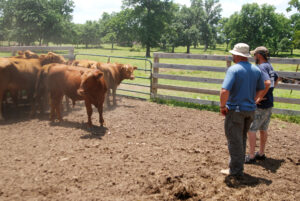
A well-constructed cattle pen provides a safe working space for livestock and livestock workers. Photo: NCAT
Working-chute dimensions for mature cattle should be around 24 inches wide and a minimum of 20 feet in length. The fence for the working chute and corral fence should be about 60 inches high. Crowding pens, which are used to force cattle into a chute, should be built to allow a density of 10 square feet per head, with 17 square feet per head for the holding pens. Longer chutes tend to cause crowding and trampling at the forward end, and should be divided into sections with sliding gates. The sides should be solid, and the crowding pen should be half again as long as the working chute and up to 12 feet wide at the open end (Huhnke and Harp, 2016).
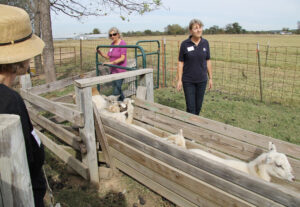
A simple working raceway for small ruminants. Note the angle of the side of the chute, designed to keep animals from turning around in the chute and facilitate ease of working. Photo: NCAT
Sheep and goats generally require the same kind of pens that cattle do, although they can be much smaller. A small-ruminant working chute should be about 10 feet long, four feet high, and 12 inches wide (Schoenian, 1999). The sides should be solid and, ideally, for horned goats, the chute should be tapered, with the top nearly twice the width of the bottom. To avoid jamming, it helps to mount a vertical roller, about 30 inches in length, at one side of the entrance to the chute. Like the cattle facility, the crowding pen should be half-again as long as the working chute and up to 12 feet wide at the open end. Premier designs small-ruminant working facilities and a good example can be found here.

A restraint can make vaccinations and other tasks easier. If it doesn’t make sense to have a chute restraint, a small set of pens with gates
can be used to sort and catch individual animals. Photo: NCAT
When you plan your livestock handling facility, make sure it is well thought out and constructed to reduce stress on the animals, as well as on you, the handler. Langston University has a Meat Goat Production Handbook with a nice section on facilities that will work well for small ruminants. For cattle, Corral and Working Facilities for Beef Cattle from Oklahoma Extension is a great resource. A system that is simple, well built, and takes into consideration species differences will make your common management tasks much more efficient, safe, and even fun!
If you are considering including pigs in your multispecies grazing operation, don’t forget about their (and your) needs when it comes to handling. Keep some pig boards on hand to assist with moving them (these will help push the pigs along and are good shields from angry sows), as well as a handling crate. Pig chutes should be about 30 inches wide, and you can walk behind the pigs with a pig board to ease them into a trailer or restraint.
A Word about Shelter
Livestock require very little in the way of shelter, but do need to be protected from wind chill, especially when it’s cold and raining. Animals use energy to maintain their body heat, and extremes in cold, accompanied by wind and rain, can cause stress, notably for young animals. For cattle, windbreaks or a grove of trees or woods can often provide what they need to get out of the weather. And, although sheep and goats don’t require much shelter, either, it’s important to note that goats typically don’t like rain. Lambing and kidding can and should, in most cases, occur on pasture, where they have access to fresh air and flock behavior, but young lambs and kids are very sensitive to wet and cold. For the safety of young animals, especially in winter and foul weather, animals can be brought into a barn prior to parturition and kept there for several days after lambing or kidding, until the young ones gain their footing and are ready for pasture. More information on shelter and other management considerations for sheep and goats can be found in the ATTRA publication Sheep and Goats: Frequently Asked Questions.
Predators
Due to their size, small livestock like sheep and goats are targets for predators such as coyotes, mountain lions, wolves, bears, and even neighborhood dogs. The first line of defense should be strong, adequate fencing. But, depending on your location and predator pressure, fencing may not be enough to protect your livestock. Sheep and goats can be protected by a combination of adequate fencing, bonding to larger livestock species (such as cattle, donkeys, or llamas), and using guardian dogs.
One of the advantages of grazing cattle and small ruminants together is that it discourages some predators from attacking the herd. This works well if the animals are bonded and stay near each other. Dean Anderson, a research animal scientist with USDA ARS, and colleagues have noted a reduction in predator losses when small ruminants are bonded to large ruminants (Anderson et al., 2012).
It will take some training at first to get cattle bonded with sheep or goats, but it’s possible. Anderson, in an article in On Pasture, discusses bonding sheep and cattle by penning young lambs with cattle for 30 days and providing a creep to allow the lambs to escape to a safe place if necessary (Voth, 2014). The article elaborates on pen bonding, provides resources for further reading, and is a good place to get information on running cattle and small ruminants together.
There is safety in size and in numbers, and an intensively managed multispecies herd will be less bothered by predation. However, this depends in part on the type and number of predators. Where predatory pressure is high, it may be necessary to use livestock guardian dogs. In some areas, intense pressure may come from stray dogs, who will chase cattle as well as sheep or goats. There may also be coyotes, wolves, or bears in a region. The Oregon State University Extension publication Raising and Training a Livestock-guarding Dog is a good source of information on livestock guardian dogs.
Starting a livestock guardian dog requires an understanding of dog behavior and the qualities of trustworthiness, attentiveness, and protectiveness. Guardian dogs are working dogs, and the training methods you’ll use are different from those used for obedience, hunting, or herding. Guardian dogs are not pets, and should be raised with livestock so they can bond and so their natural protective instincts are instilled from puppyhood. The publication Raising and Training a Livestock-guarding Dog, from Oregon State University Extension, discusses methods for raising a guardian dog and covers problems that you might encounter during the training process, as well as possible solutions.
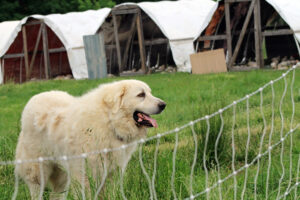
Guardian dogs may be an essential part of your farm if you have small ruminants. Photo: NCAT
Livestock guardian dogs must be bonded with the livestock they are guarding. If you have multiple species and are running a very diverse operation, it is important that the dogs are bonded with each one of the species. Your “sheep” dog should be calm around cattle, and not chase the chickens or harass the pigs.
Before acquiring a livestock guardian dog or dogs, do some research to decide what breeds will work best for you. Do not be tempted to pick up a “free” dog of mixed breed, if some of that “mix” is a guardian dog breed. Mixing the instincts of guarding with herding will usually be a problem. However, its fine to mix two or more guardian breeds (such as Anatolian Shepherd and Great Pyrenees).
The Old World guardian dog breeds share some of the same basic behaviors that make them appropriate for guarding livestock. Some of these are Anatolian Shepherd, Castro Laboreiro, Great Pyrenees, Komondor, Kuvasz, Maremma, Polish Tatra, Shar Planinetz, and Tibetan Mastiff (Lorenz and Coppinger, 2002).
Remember, having guardian dogs adds cost to the operation, but in some situations, it would be impossible to raise livestock without these protectors.
Predator Exclusion…A Few More Words on Fencing
The ability to exclude predators with fencing depends upon the predator species and the pressure, or intensity of predatory attempts on the herd. If predator pressure is low, a woven fix-knotted wire fence will suffice. The fixed knots on the wire prevent slippage when a predator (or a sheep) tries to push through. However, with more predator pressure, a fix-knotted high-tensile woven-wire fence with fiberglass posts should be used and powered with a high-joule charger. A 30- to 50-joule charger is not unwarranted here, because you want to instill fear of the fence in any predator that encounters it. Dave Scott, an ATTRA specialist and sheep rancher in Montana, recommends that producers with high predator pressure buy a charger that is twice the joule rating of what they initially think they need.
A really hot wire fence is sometimes is the only way to deter predators like coyotes and bears. As well, it is a good idea to run a hot wire along the top of the fence about 52 inches high, offset to the outside of the fence. This can be a way of preventing coyotes from jumping the fence. Think about the bottom of the fence too, because coyotes will often try to crawl under the woven wire, especially in swales and low areas where the fence is higher. A hot wire at the bottom can help to alleviate this risk.
Mineral Supplementation
Grazing different species together can cause some logistical problems that go beyond fencing and working facilities, and it requires producers to think about new ways of accommodating the needs of different animals. One of these issues is mineral supplementation. It is well known that cattle mineral should not be fed to sheep due to sheep’s lower tolerance of copper. As cattle mineral has more copper in it than sheep need, toxicity can occur if sheep consume it.
Copper Toxicity in Livestock
Sheep require less copper than goats and cattle. Remember… even though sheep require less copper than cattle, they still require it in their diets. Do not forgo mineral for sheep just because you are worried about copper toxicity. Veterinarians have reported copper deficiencies in sheep because producers have been too careful and have withdrawn copper from their diet.
There are a few tricks producers can use to help ensure that animals get the minerals they need without overdosing on copper. One way is to feed sheep mineral to all species. This can work during much of the year without a problem, though it might be necessary to provide more copper to cattle during their third trimester of gestation, to meet all their needs. Then, it’s advisable, if all species are still pastured together, to feed cattle mineral in a feeder that is at least 30 inches high to keep it out of reach of the sheep. In this instance, a creep feeder can be set up for sheep to access mineral that is more appropriate for them.
Margo Hale, an ATTRA specialist and sheep producer in Arkansas, has found that when pastures have a high degree of nutrient cycling (and thus require very little fertilization), there is little need for sheep mineral other than 30 to 40 days pre-breeding and 45 days before lambing, as well as during the first 30 days of lactation. In healthy pastures, soil microorganisms do the work to provide a nutrient-dense forage that meets animals’ needs. Many holistic graziers (including Gabe Brown, who grazes livestock on cover crops as part of his crop rotation) no longer feed cattle mineral when grazing their pastures. Instead, they rely on diversity, nutrient cycling, and soil health to provide for their animals’ needs. For more information on this topic, see the ATTRA publication Building Healthy Pasture Soils.
If you use a leader-follower method, where cattle and sheep are on different pastures, you could use portable feeders to provide each species their customized minerals. If your operation includes cattle and goats but not sheep, you may simply offer a good cattle mineral to both. Another method is to provide copper boluses (copper oxide) for sheep and goats. This not only provides necessary mineral but can help with parasite control. See more about parasites below.
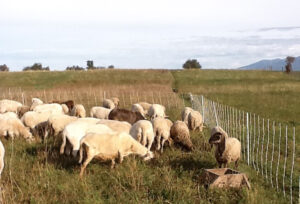
A small, portable mineral feeder can be used with electric netting to isolate sheep and feed them the appropriate mineral. Photo: Dave Scott, NCAT
Poultry litter and swine manure are commonly used on many livestock farms for pasture fertility. If you have sheep, be careful with this practice, as these manures tend to have higher concentrations of copper than cattle manure. Testing soils and forages will be the best way to learn the mineral status of your pastures. In some regions of the country, forages are copper-deficient even with poultry litter being used. It’s a great idea to work with a nutritionist on mineral supplementation.
Managing Internal Parasites
Perhaps one of the most notable benefits of multispecies grazing is its effect on parasite management. Cattle will consume parasite larvae such as the Barber Pole Worm, which only infects sheep and goats, and because this worm is incompatible with cattle, the worms will die. The same thing happens when small ruminants consume parasites that are indigenous to cattle. Because of parasite larval incompatibility between species, cattle can be grazed after or with small ruminants to reduce the incidence of larval infection.
Managing sward height is key in controlling internal parasites. As worm larvae emerge, they travel up the leaf blades of grasses to position themselves right in the way of a grazing animal as it eats, but they usually don’t climb higher than four inches. As long as you keep grazing to the top leaves of the sward, and move the animals before they graze too low, you can significantly reduce infection. Try to maintain at least a 6-inch residual after grazing. Also, give the paddocks a nice long recovery period. This is not only good for pasture health and resiliency; it also allows parasites to die off in the pasture before they can be consumed by a grazing animal. Use a 40-day recovery period at the very least in pastures you know to be infected by parasite larvae.
In addition, you can also use a shorter grazing period. Again, this benefits pasture health because plants begin to regrow around three or four days after they have been grazed, and getting the animals off to allow for regrowth is a key management consideration in multi-paddock rotational grazing. But it also works to break the parasite’s life cycle. By moving the animals off a pasture before day four, you’ve effectively moved them before the larvae are able to move up into the sward to be consumed by animals.
Strategic grazing can be used to control Barber Pole Worm while reducing dewormer use. Paddock rest, height of residual forage after grazing, and timing of grazing can have big impacts on infection. A great resource to help you manage parasites through grazing is the ATTRA tipsheet Grazing to Control Parasites.
Additionally in ATTRA’s webinar, Integrated Parasite Management Training – Barber Pole Worm, livestock and sheep specialists from Montana, Wyoming and Idaho cover how to deworm strategically using FAMACHA scoring, grazing properly to avoid Barber Pole worm ingestion, and using genetic selection to mitigate the devastating influence the Barber Pole Worm can have on your flock.
If you have a pasture that is infected with larvae and are having a hard time ridding the herd or flock of parasitism, you can take the pasture out of the grazing cycle for a few rotations. Steve Hart of Langston University recommends resting an infected pasture for six weeks in the hot summer, taking the forage off as hay at four weeks, then resting it another two weeks. After this, the parasite’s life cycle should be broken and you should be able to continue grazing as usual (Hart, 2014).
Think about your common areas too, such as a barn lot or shady areas where animals congregate. It is probably best to provide water in the pasture, and not in a central location where animals will be continuously grazing and re-infecting themselves.
Some plants are known to reduce parasitism in livestock. Consider adding some tannin-producing plants such as Sericea lespedeza, sainfoin, or chicory to your pastures. These plants have been known to cause as much as a 50% reduction in fecal parasite egg counts (Hart, 2014). See the ATTRA publications Tools for Managing Internal Parasites in Sheep and Goats: Sericea Lespedeza and Tools for Managing Internal Parasites in Sheep and Goats: Pasture Management for more information.
Certain tannin-producing forage plants such as Sericea lespedeza, birdsfoot trefoil, and sainfoin can be used in an integrated parasite-control program to reduce the incidence of parasites on pastures. The tannins in these plants are known to disrupt the ability of worms to infect small ruminants (O’Brien, 2018). Additionally, these tannins will alleviate bloat while animals are grazing grass-legume pastures, which is a nice plus!
For more information, take a look at the ATTRA publication Tools for Managing Internal Parasites in Small Ruminants: Sericea Lespedeza.
Animals can deal with a certain amount of parasitism. The key here is maintaining a healthy herd or flock and fostering natural immunity through good nutrition, clean fresh water, and pasture access. However, one of the best methods for controlling parasitism, in addition to observation and targeted treatment, is culling of repeat offenders and selection for resistance when breeding and acquiring new animals.
You’ll never be able to completely eradicate internal parasites in livestock. However, an integrated management system with combined livestock species can certainly make a dent in their populations. There will always be some parasites in a herd or flock, and otherwise-healthy animals can deal with a slight parasite load. Additionally, cattle can usually handle parasites much better than small ruminants. The goal is to manage the parasites that remain in a herd such that treatments can be effective against them. This population of parasites in the herd or flock is called refugia. Essentially, this population remains relatively unexposed to dewormers and reduces the incidence of dewormer resistance.
For more on dealing with small ruminant parasites, including refugia and dewormer resistance, see the ATTRA publications Managing Internal Parasites in Sheep and Goats and Managing Internal Parasites: Success Stories, which includes Paul Casey’s description of how they use multispecies grazing at Heifer Ranch.
Animal-Health Considerations
A holistic, multispecies grazing system can reduce the risk of disease due to the natural immunity effect of healthy animals on diverse pasture, as well as the benefits of being outdoors, with optimum air exchange and reduced stress in livestock. However, stress and an unclean environment can tip the scales and may allow cross-contamination of some diseases. The importance of stress reduction and cleanliness cannot be overemphasized, as the absence of these often results in numerous health-related issues from scours to pneumonia. Anything we can do to reduce stress and increase natural immunity through grazing management and good nutrition will bolster our herds, whether they be single or multispecies operations.
Causes of Stress in Livestock Herds
- Transportation
- Crowding of young animals
- New environments
- Lack of adequate ventilation
- Changes in rations and feedstuffs
- Improper animal handling
- Inadequate nutrition
- Predation
- Weaning
- Weather extremes (heat, cold, and extended periods of rain or drought)
Stocking-Rate Decisions
Before you add a new livestock species to your herd, it’s good to evaluate your initial stocking rate. How many animals do you have and how are they using the pastures? Are you managing grazing such that the livestock are taking half and leaving half? Leaving half of the forage volume in the pasture after grazing is crucial for maintaining soil cover and allowing for adequate plant regrowth. When you add animals, you don’t want to add more than the pasture can sustain.
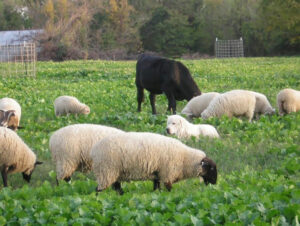
Photo: Linda Coffey, NCAT
The goal in determining a stocking rate is to find a combination of two or more livestock species that will produce more total gain within a multispecies grazing system than within single-species grazing, while maintaining the integrity of the pasture ecology and improving the pasture composition. There’s no hard-and-fast rule for determining a stocking rate, but as with single-species systems, it should be based on empirical observation of forage production and plant composition.
On your farm, your stocking rate will likely vary from year to year, and even from season to season. Your stocking rate will change depending on temperature, rainfall, pasture composition, animal growth rates, and many other factors. Also, remember that sheep and goat herds grow more quickly than cattle herds. Within a few months you can easily go from 50 sheep to 150 sheep, and this will place added pressure on your pastures. Be sure to take this increased herd size into account when you are planning your grazing.
Stocking rate is dependent on the available forage resources on the landscape and the kind of management employed to ensure pastures are well rested. Most operations are really overstocked, and adding animals can be a train wreck if a careful inventory of forage resources isn’t accomplished. If you have adequate, diverse forages, maintain a short grazing period, move animals regularly, and provide adequate pasture rest, you can increase your stocking rate. Remember: implement, observe, adapt.
If you are just starting out with multispecies grazing, it might be best to stock a little conservatively. This will allow you to observe and adapt. Greg Brann, a multispecies grazier in Tennessee and a retired NRCS professional, suggests matching the livestock stocking ratio to the vegetation that livestock prefer. He’s found that a 1:1 or 1:2 ratio of sheep to cattle works well (Brann, 2018).
As well, Hue Karreman stocks one ewe per cow without adjusting his stocking rate, and maintains a low stocking density. This works well in his system, where he follows cattle and sheep with poultry three days after the cows and sheep leave the paddock. At this time, the dung beetles have done their business and the fly larvae are beginning to emerge in manure, giving the chickens a tasty meal.
Scaling Up: Managing Your Multispecies Grazing More Intensively
Once you have a good understanding of how your pastures are responding to your animal numbers, you may be able to increase stocking even more by managing the grazing more intensively. Here, understanding animal unit equivalents can establish a starting point for making further stocking decisions.
| Table 1. Animal Unit Equivalent Chart | |
| Cow (1,000 lbs) | 1 |
| Cow (1,000 lbs) with calf | 1.1 |
| Cow (1,200 lbs) with calf | 1.2 |
| Yearling cattle | 0.75 |
| Sheep, mature lactating ewe (150 lbs) with lamb, less than 2 months | 0.17 |
| Sheep, mature non-lactating ewe | 0.15 |
| Lamb, yearling | 0.15 |
| Goat, mature | 0.15 |
| Kid, yearling | 0.1 |
| Swine, over 300 pounds | 0.4 |
| Swine, between 55 and 300 pounds | 0.3 |
| Adapted from Minnesota Dept. of Agriculture and NRCS (2006) | |
Animal unit equivalents are sometimes used to help producers estimate stocking rates on rangeland and pastures. This measurement reduces various species of livestock (and wildlife) to an equivalent based on a 1,000-pound cow, and is determined by dividing the average weight of an animal by 1,000 pounds. So, a goat weighing 150 pounds would have an animal unit equivalent (AUE) of 0.15.
For example, if your pasture has an estimated carrying capacity of 100 animal units (or 100 cows) and you want to stock 75 goats weighing an average of 150 pounds, you could use the formula provided by Lyons and Machen (2011):
75 goats ÷ 0.15 = 11 goat animal units
100 animal units – 11 goat animal units = 89 cow animal units
In this scenario you could stock 75 goats and 89 cows (the numbers are rounded to make it easier to calculate stocking because in real life animals aren’t expressed as fractions).
A main difference between stocking single species and multiple species is the idea of dietary overlap. Livestock species, as mentioned earlier, choose diets composed of forages appropriate to their grazing habits and physical characteristics. However, cattle, sheep, and goats do not merely choose either grasses, forbs, or browse, respectively. There’s some overlap here, and it’s known that, for instance, goat diets will in general be composed of roughly 30% grass, upon which cattle tend to concentrate their diet selection. The goal of a multispecies grazier is to stock pastures with the appropriate combination of livestock species to best utilize the pasture without causing degradation to the forage or soil resource.
“Determining stocking rates for combinations of animal species is controversial. The controversy centers around whether to consider diet overlap between species” (Lyons and Machen, 2011). When stocking multiple species on the same landscape, a producer can either consider overlap or assume all animals consume 100% of the same forages. Which route to choose depends on forage-species variability and how intensively the pasture is managed.
The easiest way to determine multispecies stocking is to forget about dietary overlap and assume all animals consume the same amount of all forage species in the pasture. For pastures that are rotated very slowly (with long grazing periods of a week to several months) with moderate stocking, ignoring dietary overlap might not be the best practice. Managing pastures less intensively, with continuous grazing in the same areas, increases grazing selectivity by livestock.
However, ignoring dietary overlap may be warranted if you’re using intensively managed, multi-paddock rotational grazing. With this practice, pastures are densely stocked for short periods of time (with a grazing period of less than four days). In a densely stocked system such as this, grazing selectivity is decreased and competition among animals is increased. A producer who uses multi-paddock, high-density rotational grazing might be able to convert all animals, regardless of species, to animal units and stock accordingly.
In our example, let’s assume a 50% dietary overlap between goats and cattle (meaning only 50% of their diets are the same). If we adjust our formula to account for dietary overlap, we get the following (again, with some rounding):
75 goats ÷ 0.15 = 11 goat animal units
11 goat animal units x 0.5 diet overlap with cattle = 5 goat animal units
100 animal units – 5 goat animal units = 95 cow animal units
When we account for dietary overlap in this scenario, we increase the number of cows being stocked from 89 to 95 because each livestock species places less pressure on the plants the other species focuses on.
Dietary overlap is a moving target throughout the grazing period. In periods of high forage variety and availability, overlap tends to increase as each species utilizes more of the same forages (Walker, 1994; Squires, 1982). As available forage decreases, dietary overlap tends to decrease.For example, in dry times, when forage availability and variability is reduced, cattle shift to lower-quality forages, whereas sheep tend to keep their preferred diet (Walker, 1994). This is likely a function of their grazing habits and the animal’s particular morphological characteristics and ability to access certain forages. Remember: sheep and goats need better forages than do cattle. And the weeds and browse that they prefer may be higher in nutritional quality than grass during summer.
In the situation above, some would say, “How can I remove only five cows but gain 75 goats?” This is a good question to ask. There are a lot of factors here that need to be teased out. First off, remember this is assuming 50% dietary overlap, so the different livestock species will not be eating all of the same forages. Next, think about pasture diversity. This scenario also assumes that there is enough variation in forage species to provide for each livestock species without encroaching too much on the others’ diet. Third, there must be adequate forage. Pasture rest and grazing period should be controlled to ensure that enough forages are present to meet the needs of a large herd/flock.
In fact, the idea of doubling the number of animals on a farm or ranch has been tested empirically by the North Dakota State University Dickinson Research Extension Center. They’ve noted that they could add one sheep for each cow with no reduction in stocking rates, and with no added pressure to the forage base, because of the complementary nature of sheep grazing diets compared with cattle. The North Dakota study also found that, given the one-to-one addition of sheep to a cow operation, net return per animal unit can be increased by more than 65% (Ringwall, 2017). With this kind of return, the inherent risks of multispecies grazing seem well worth the extra time and attention.
The key terms to keep in mind when adding so many more animals to your herd are diversity, rest, and grazing period. When these three concepts are managed well, a multispecies grazing system can greatly increase the carrying capacity and productivity of the pasture. See the Grazing Planning and Monitoring section for more detail on managed grazing.
Grazing Pigs
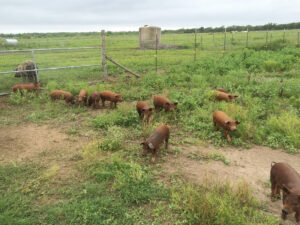
Pigs on pasture at A*Y*RAAM Farms in Kingsbury, Texas. Photo: Andy Pressman, NCAT
Pigs can be an excellent addition to a multispecies grazing operation. They work well following cattle and sheep, and can help renovate old, worn-out pastures. Maintaining adequate ground cover is a challenge for pastured swine producers, and, if not managed, pigs will strip a pasture bare, which has negative impacts on soil and water quality. With that in mind, here are a few thoughts that can greatly help you when adding pigs to a grazing operation:
Provide a varied pasture mix of diverse legumes, forbs, and grasses. Stock the pigs appropriately with around 15 to 20 growing pigs or four to seven sows per acre. Rotate pastures! Make sure there is adequate time for pasture regrowth. Also, pigs need space to wallow; give them shade and a wallow that is not where they get drinking water. Make sure you provide enough energy supplementation to meet their needs. Tom Franzen, a pig producer in Iowa, recommends keeping roughage to less than 5% of the diet for 40- to 150-pound pigs, and 30% of the diet for 150- to 200-pound pigs. For large, mature pigs, keep roughage to no more than 50% of the diet. Always provide lysine, vitamins, and mineral supplementation. And, a profitable pig operation must supply a pig’s energy needs because they cannot be obtained with pasture alone. Corn and soybeans are best for providing concentrated nutrients.
Grazing Planning and Monitoring
A grazing plan brings all of your planning efforts into fruition by allocating stocking throughout the grazing season. Your plan will help you match the forage resources to animal demand while ensuring an appropriate grazing period (time on pasture) and adequate pasture rest. These two concepts (grazing period and rest) are fundamental to sustainable pasture management.
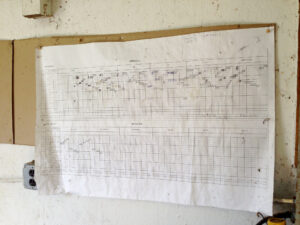
A grazing chart on the wall of the barn, milk house, or offi ce can capture and record rainfall, forage production, and all your management activities in one place. Photo: Lee Rinehart, NCAT
There are many benefits to having a grazing plan and schedule. A grazing plan will allow you to balance forage productivity with animal intake requirements, plan pasture use before the grazing season starts, and obtain accurate information on forage productivity and use. It will also provide documentation for programs and certifications, such as NRCS conservation cost-share programs and organic certification requirements.
A grazing schedule can serve as a summary of all management activities and monitoring conducted on each pasture. You can develop a chart or get a notebook to write down the events, monitoring indicators, and management tasks that are most important to you, such as the following:
- Animal weights
- Breeding
- Calving, lambing, and kidding
- Grazing period (days on each paddock)
- Paddock recovery period
- Rainfall or snowfall and temperature
- Forage yield
- Forage residual after grazing
- And more.
Pasture monitoring is particularly important because the information obtained will inform your grazing planning for the season and the next year. This provides a necessary feedback loop to validate and update your grazing decisions.
Determining Dietary Overlap among Species
Similarity in animal diets is not easy to determine. There are so many variables that contribute to dietary overlap between species that coming up with a really accurate figure is almost impossible without conducting a complex grazing study on your farm. Forage types, species, season, water availability, temperature, and grazing pressure all contribute to dietary overlap, and it changes among the seasons.
Probably the best way to estimate overlap, unless you are really confident with your own observations, is to assume that it is high in the spring and low in the summer. For cattle and sheep, this may mean a dietary overlap of about 75% in spring and 60% in summer, while there is a dietary overlap of about 50% in spring and 40% in summer for cattle and goats. Settle on a figure you are comfortable with, put the animals together and observe them for a season. Was there any excess pressure on any key forage species? Did cattle eat more browse than you thought they would? Write down your observations and check again the following season to see if there is a pattern. Like any planned grazing system, multispecies grazing requires keen observation and continual adaptation. As you implement, monitor, and record, you’ll likely find that your observations become more accurate.
ATTRA has developed some in-depth resources and training programs to help you plan, implement, and monitor your managed grazing system:
Managed Grazing Tutorial
This course was designed to help producers manage toward productivity and resilience. Topics include inventory, infrastructure, managing the mature stand, intensifying grazing, stockpiling, fertility and soil health, and monitoring.
Grazier’s One-Stop Resource Packet
Includes useful planning tools for managed grazing, including a Clip and Weigh Forage Yield Calculator, Grazier’s Calculator for matching forage to animal demand, a Monitoring Checklist, and a Grazier’s Math tipsheet with useful formulas.
Business planning, processing, and marketing are integral to any successful livestock operation. Think of them as bookends on a bookshelf. All the fun stuff like handling and moving animals, feeding, managing pasture, and observing grazing behavior are the books the reason you have the bookshelf. But without strong bookends to hold them in place, any disruption can cause them to tip over. Your first bookend is a good business and marketing plan. This will help you plan cash flow and will provide a roadmap for selling your product. The other bookend is having a good handle on meat processing and what happens to your product when it leaves the farm. Four great resources to check out to complete your bookshelf are:
- Building a Sustainable Business: A Guide to Developing a Business Plan for Farms and Rural Businesses (SARE)
- Marketing Tip Sheet Series (ATTRA)
- Working with Your Meat Processor (ATTRA)
- Direct Marketing Lamb: A Pathway (ATTRA)
It is important to recognize that with multiple species you have multiple enterprises with different marketing needs. Your marketing plan should take these differences into consideration. Cattle are marketed annually if you’re selling calves and every other year if you are marketing fed cattle. When you add sheep and goats, your products (animals, meat, wool) will need to be marketed more frequently than if you are running cattle alone.
Summary
Perhaps after reading this publication you have a better sense of the intricacies of managing multiple species on pasture. Certainly, grazing diverse livestock species on diverse pastures can have positive impacts on productivity, profitability, and ecological resiliency. Just keep in mind some of the main principles covered here and observe, adapt, and adjust.
Fencing, bonding with cattle, and guard dogs are means of mitigating the risk of predation loss, but they are not an absolute control. In deciding to graze multiple species or not, you must weigh the benefits of multispecies grazing (increased income, increased carrying capacity of pastures, and increased soil health benefits) against the predation risk. If, as the North Dakota study cited earlier suggests, you can realize a 65% increase in income per animal per year, multispecies grazing can be very well worth the risk of predation.
This publication has referenced many publications and resources to help you with parasite control, stocking, and marketing livestock products. These were chosen to provide further detail and allow you to go in depth on subjects for which you have particular questions. Place particular attention on pasture assessment, planning, and monitoring (see Grazier’s One-Stop Resource Packet) as careful planning is the foundation of any grazing operation.
Remember, multispecies grazing is all about matching animals to the appropriate landscape. It’s about having the right fencing and working facilities for the species you’re working with. It’s about managing parasites and predation, and ensuring proper mineral supplementation. Finally, it’s about determining an accurate stocking rate to use the pasture resource efficiently and sustainably. With these principles in mind, combining multiple species on pasture can be successful, profitable, and fun.
References
Anderson, Dean, E. L. Fredrickson, and Rick Estell. 2012. Managing livestock using animal behavior: Mixed-species stocking and flerds. Animal. Vol. 6, No. 8. p. 1339-1349.
Brann, Greg. 2018. Email communication.
Fraser M.D., J.M., Moorby J.E. Vale, and D.M. Evans. 2014. Mixed grazing systems benefit both upland biodiversity and livestock production. PLoS ONE. Vol. 9, No. 2. p. e89054.
Hart, Steve. 2014. Parasite Control with Multispecies and Rotational Grazing. Langston University.
Huhnke, Raymond L., and Sam Harp. 2016. Corral and Working Facilities for Beef Cattle. Oklahoma Cooperative Extension Service.
Karreman, Hue. 2018. Personal communication.
Launchbaugh, Karen. 2016. Multi Species Grazing. YouTube Video. University of Idaho.
Lorenz, J.R., and L. Coppinger. 2002. Raising and Training a Livestock-guarding Dog. Oregon State University Extension.
Lyons, Robert K., and Richard V. Machen. 2011. Stocking Rate: The Key Grazing Management Decision. Texas Agrilife Extension.
MDA. Animal Unit Calculation Worksheet. Minnesota Department of Agriculture.
NRCS. 2006. Animal Unit Equivalent Guide. In: Chapter 6, National Range and Pasture Handbook. USDA-Natural Resources Conservation Service.
O’Brien, Dahlia. 2018. Managing Dewormer Resistance. American Consortium for Small Ruminant Parasite Control.
Ringwall, Kris. 2017. Could you make money by adding a ewe for every cow in your herd? On Pasture.
Schoenian, Susan. 1999. Facilities and Equipment for Commercial Meat Goat Production. University of Maryland Cooperative Extension.
Squires, V.R. 1982. Dietary overlap between sheep, cattle, and goats when grazing in common. Journal of Range Management. Vol. 35, No. l. p. 116-119.
Voth, Kathy. 2014. Flerds: Sheep and cattle grazing together for predator control and pasture management. On Pasture.
Walker, John. 1994. Multispecies Grazing: The ecological advantage. Sheep Research Journal, Special Issue.
Further Resources
American Consortium for Small Ruminant Parasite Control
Combination Dewormers: The Time is Now. 2017. American Consortium for Small Ruminant Parasite Control.
Corral and Working Facilities for Beef Cattle. 2016. By Raymond L. Huhnke and Sam Harp. Oklahoma Cooperative Extension Service.
Livestock Guardian Dogs. 2015. By R. Reid Redden, John M. Tomeček, and John W. Walker. Texas A&M University.
Livestock Guardians Protect the Flock. 2016. By Linda Coffey. On Pasture.
Meat Goat Production Handbook, 2nd edition. 2015. Langston University.
Multispecies Grazing and Leafy Spurge Manual. 2001. By Steve Merritt, Chad Prosser, Kevin Sedivec, and Dean Bangsund. TEAM Leafy Spurge, USDA-Agricultural Research Service Northern Plains Agricultural Laboratory, Sidney, Montana.
Multispecies Grazing Systems. No date. By Morgan Doran. In: Outdoor Hog Production: Best Practices for Resource Conservation in the San Francisco Bay Area. University of California Cooperative Extension.
Multi-species Grazing for Sustainable Farming (video). 2013. By Greg Brann. USDA NRCS East National Technical Support Center.
Raising and Training a Livestock-guarding Dog. 2002. By J.R. Lorenz and L. Coppinger. Oregon State University Extension.
Targeted Grazing: A Natural Approach to Vegetation Management and Landscape Enhancement–A handbook on grazing as a new ecological service. 2006. Edited by Karen Launchbaugh. American Sheep Industry Association.
Multispecies Grazing: A Primer on Diversity
By Lee Rinehart, NCAT Agriculture Specialist
Published September 2018
©NCAT
IP570
Slot 154
Version 091318
This publication is produced by the National Center for Appropriate Technology through the ATTRA Sustainable Agriculture program, under a cooperative agreement with USDA Rural Development. ATTRA.NCAT.ORG.
Related Publications
- Managed Grazing Tutorial
- Building Healthy Pasture Soils
- Grazier’s One-Stop Resource Packet
- Grazing to Control Parasites
- Managing Internal Parasites in Sheep and Goats
- Meat Goats: Sustainable Production
- Nutrient Cycling in Pastures
- Paddock Design, Fencing, Water Systems, and Livestock Movement Strategies for Multi-Paddock Grazing
- Pasture, Rangeland, and Adaptive Grazing
- Pastured Poultry: Egg Production
- Predator Control for Sustainable & Organic Livestock Production
- Ruminant Nutrition for Graziers
- Sheep and Goats: Frequently Asked Questions
- Sheep: Sustainable and Organic Production

